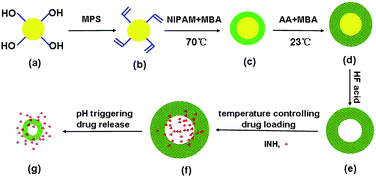Dual stimuli responsive hollow nanogels with IPN structure for temperature controlling drug loading and pH triggering drug release†
Abstract
Monodisperse temperature/pH dual stimuli responsive hollow nanogels with an interpenetrating

* Corresponding authors
a
State Key Laboratory for Modification of Chemical Fibers and Polymer Materials, Donghua University, Shanghai, People's Republic of China
E-mail:
lszha@dhu.edu.cn
b Research Center for Analysis and Measurement, Donghua University, Shanghai, People's Republic of China
Monodisperse temperature/pH dual stimuli responsive hollow nanogels with an interpenetrating

 Please wait while we load your content...
Something went wrong. Try again?
Please wait while we load your content...
Something went wrong. Try again?
Z. Xing, C. Wang, J. Yan, L. Zhang, L. Li and L. Zha, Soft Matter, 2011, 7, 7992 DOI: 10.1039/C1SM05925D
To request permission to reproduce material from this article, please go to the Copyright Clearance Center request page.
If you are an author contributing to an RSC publication, you do not need to request permission provided correct acknowledgement is given.
If you are the author of this article, you do not need to request permission to reproduce figures and diagrams provided correct acknowledgement is given. If you want to reproduce the whole article in a third-party publication (excluding your thesis/dissertation for which permission is not required) please go to the Copyright Clearance Center request page.
Read more about how to correctly acknowledge RSC content.
 Fetching data from CrossRef.
Fetching data from CrossRef.
This may take some time to load.
Loading related content
